Blues Brothers — Jack and Bert Sharp
The story of two brothers: one an international-standard cricketer and footballer who was named an Everton Giant earlier this century; the other having a career in the same sports, but something of a footnote in the Club's history
Footballing brothers are far from unique but it’s rare to have two in the same club side. The Wallace brothers at Southampton and the Nevilles at Manchester United are examples in relatively recent times. At Everton in the early 1900s Bob and Billy Balmer were mainstays in the club’s backline (Billy having the honour of being the club’s first ’Scouse’ player capped by England). The Balmers racked up 518 appearances between them, but, more often than not, one footballing brother has outshone the other. That was the case with the Bell brothers. John, a Scottish international, was considerably more celebrated than fellow-forward Laurie. It was a similar story with the Sharp brothers, Bert and Jack.
Most Everton supporters of a certain age will be familiar with the name Jack Sharp – mainly for the eponymous sports shop business. His successful business career was matched by success as an international-standard cricketer and footballer. Jack was one of the original players to be given Everton Giant status, in 2000. Bert followed a similar path to his sibling, having a career in the same sports, but never hit the same heights and is something of a footnote in the history of the Toffees. This, then, is the story of the Blues’ Sharp brothers.
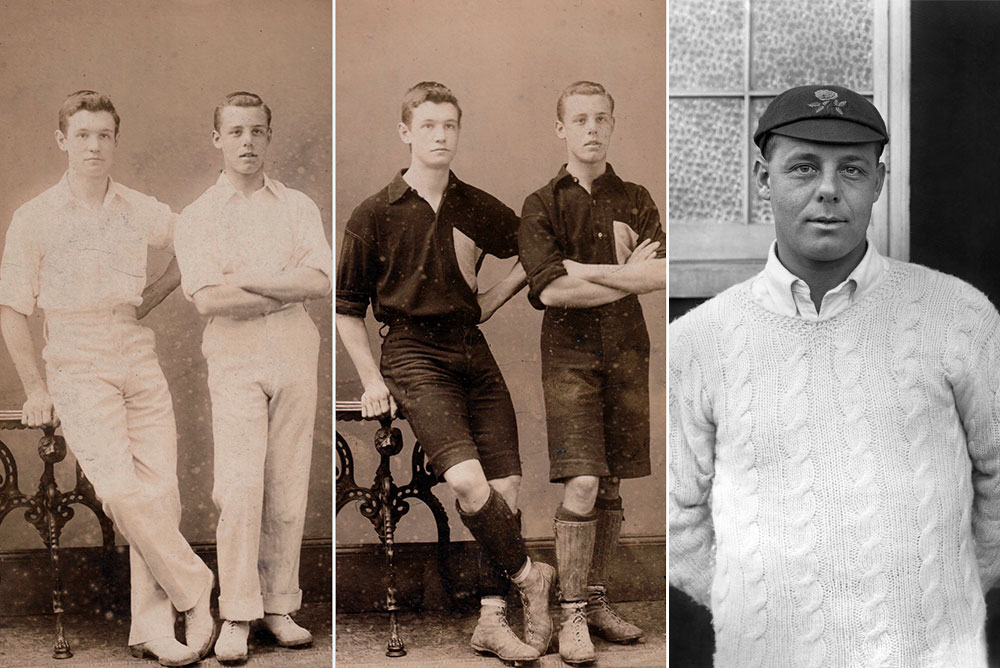
Left and middle: Teenage brothers in their cricket and football attire; Right: Jack the cricketer
Although closely associated with Everton and Lancashire (notably Merseyside and Manchester), their roots lay in Herefordshire. Their father was Dorking-born Charles Sharp, a Hereford butcher who had other business interests in the town. Their mother, Annie (maiden name, Reed), hailed from County Meath in Ireland. The family, which included four children, resided at 8 Eign Street. Bertram (Bert) was born 8 January 1876, with John (Jack) being born on 15 February 1878, a notable year for football on Merseyside.
This sporty pair grew up playing football and cricket in their hometown. Jack broke scoring records at centre-forward for Hereford Thistle while Bert performed capably at full-back in the same team. Matches were played at The Barracks ground on Harold Street; The Grapes Tavern (which Charles Sharp had a stake in) doubled as the team’s HQ.
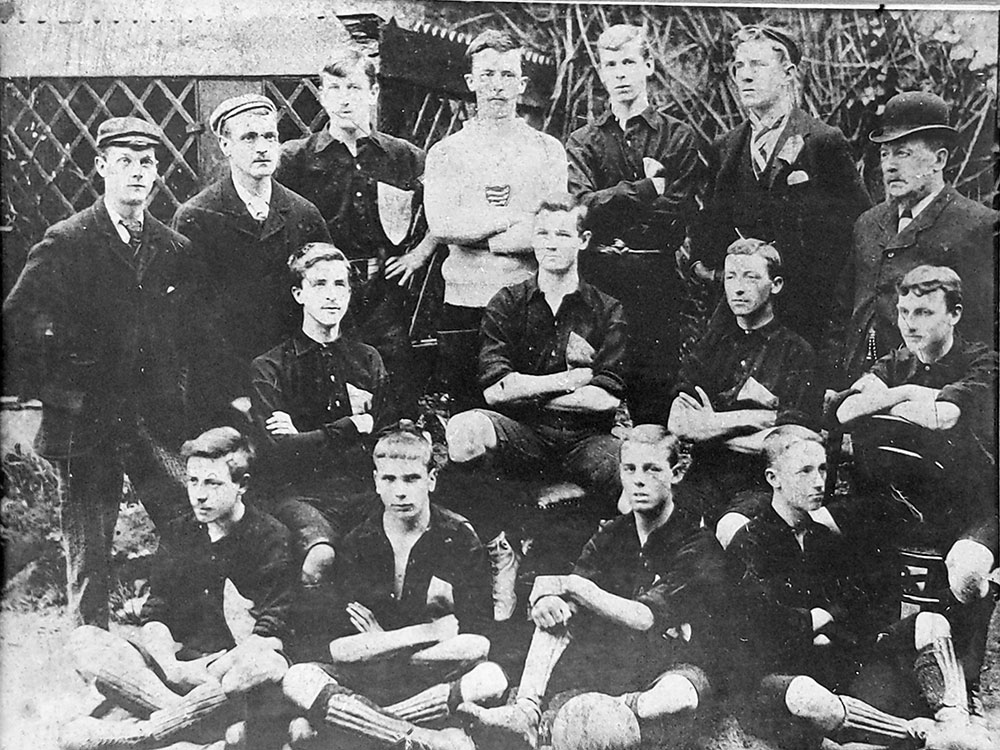
Hereford Thistle with Bert, captain, in middle row and Jack sat on the ground
In 1895, Thistle won the Bristol League, progressing to the Birmingham and District League. Jack’s displays piqued the interest of Aston Villa, who fielded a reserve team in the same competition. The reigning Football League champions signed the two brothers in 1897 – but had to make a trek by train to Preston to sign the younger brother. Jack had been engaged by Leyland cricket club, one of the country’s top outfits (having joined Liverpool Cricket Club, based in Aigburth, two years previously).
In his first season at Villa Park, Jack was not a regular pick at centre-forward but, during the following campaign, an injury to Charlie Athersmith gave him an opportunity on the right wing. Compact with a low centre of gravity at 5’6”, the forward was brave, fast, direct and blessed with a strong shot (eventually earning the nickname ‘Pocket Hercules’). Jack impressed in this new wide position but had to make way when Athersmith returned to fitness. Bert, meanwhile, debuted for the Villains against Bolton Wanderers on 2 October 1897. He made 19 appearances in that season, at both full-back and wing-half, but followed it up with just four outings in his second season in Birmingham, his last pick coming on New Year’s Eve.
Come the spring of 1899, the brothers were looking to kickstart their stagnating football careers. Several clubs linked and Jack was attracted by the prospect of teaming up with England striker Steve Bloomer at Derby County. However, with the transfer to the Rams on the verge of completion, an Everton delegation rushed to Birmingham. It was Bert that they coveted most, but were happy to make a double-swoop. They held a trump card which helped to seal the £450 deal: Everton’s geographical location. Jack later recalled to the Athletic News: ‘I had cricket in view as well. I had made up my mind to qualify for Lancashire. But for this cricket ambition I should have joined Derby County.’
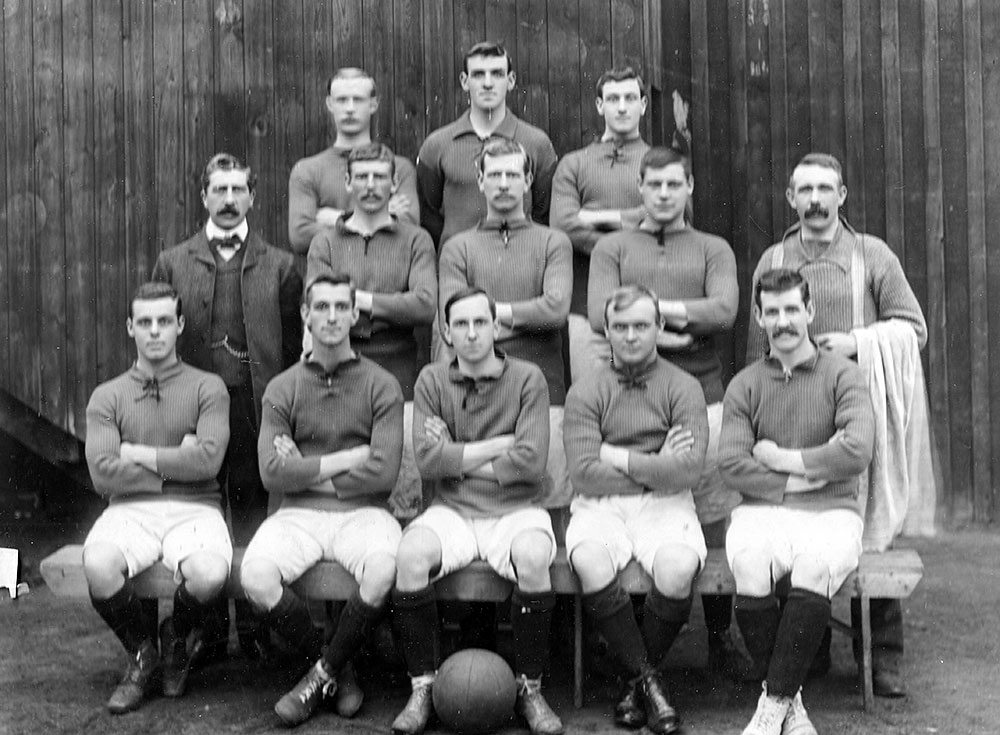
Everton c 1901 — Jack Sharp front left
The fraternal pair would make their Toffees debuts during the following season. Bert made three appearances as a full-back in December- his debut came, ironically, against Derby County, before falling back out of favour. Within six months he had departed for Southampton FC (Everton retained his Football League registration). He was one of several Toffeemen to throw their lot in with the Saints and he went on to win the Southern League title there.
At Everton, Jack found himself in a strong forward line which boasted recent signings Walter Abbot and Jimmy Settle. Settle, boasting similar pace and stature to Jack, established himself as an international class inside-forward. In an early outing, reporters noted the blossoming understanding between the diminutive duo. With a number of new faces in the team, the 1899-1900 season was a transitional one. Jack’s five goals in 29 appearances contributed to an 11th place finish in the league.
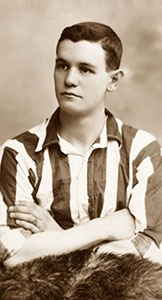
Bert Sharp at Southampton
After 32 appearances and one goal in the red-and-white stripes of Southampton, Bert returned to was back with his ‘parent’ club, making his second ‘debut’ in a 4-0 win in the January 1902 Merseyside. Six more first team appearances followed at full-back. This brought to an end his elite level football career, which comprised 31 appearances in all for Villa and Everton. He went on to have brief spells at Kirkdale FC and Southport Central. He later lamented that he might have enjoyed a more productive time had he joined Derby in 1899. Although not hitting that heights of his brother’s achievements with bat and cricket ball, Bert served as the club professional at Bootle CC, and was still handy as a batsman and bowler into the 1920s. He had married Margaret (‘Peg’) Parle in 1900 and they had three children together, Edna, Cyril and Margaret. In 1904, Bert became landlord of a pub that’s now the site occupied by Hot Wok, on the corner of Spellow Lane and Walton Lane. Seven years later the family was living at the Salutation, a small pub on Walton Road. In 1921 they were resident at the more grandly proportioned Plough Inn on Rice Lane. In 1928 Cyril signed for Liverpool FC but the young inside-left didn’t make the grade.
Jack had wed Mary Annette Scott, a Stopfordian, at St Bride’s Church, Old Trafford, in April 1902. The couple went on to have three children (Jack Jr., Madeleine and Geoffrey) who, in time, would become involved in the family sporting equipment business which Jack founded the year after the wedding. His store in Whitechapel was, for many decades, a mecca for those seeking sporting goods and apparel – as well as match tickets. The company logo was a depiction of a sportsman in half-and-half cricket whites and football kit with the strapline Jack O’Both Sides.
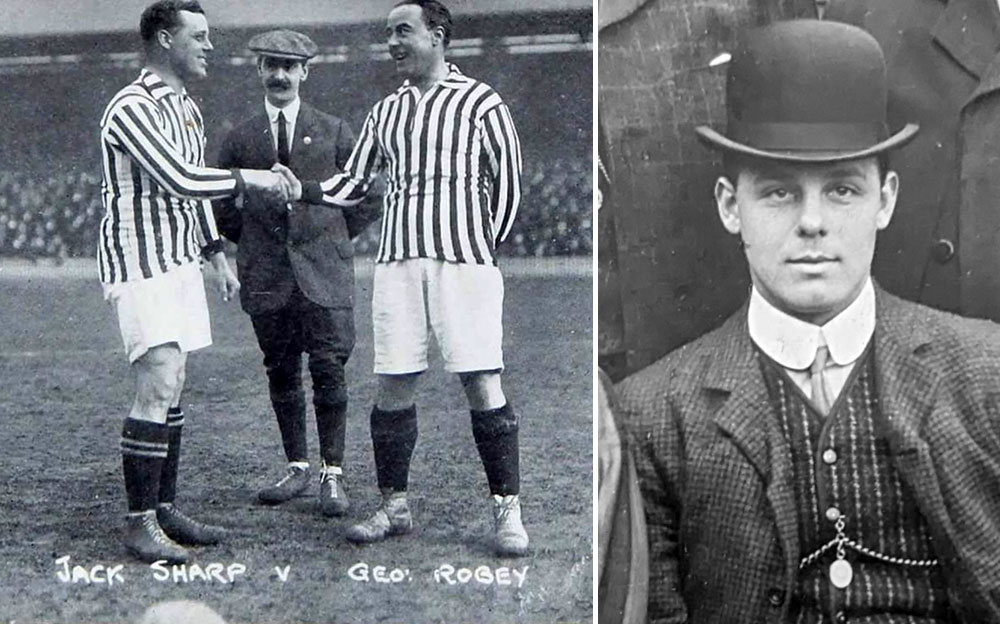
Left: Jack with comedian George Robey before a charity match; Right: Bowler-hatted Jack circa 1902
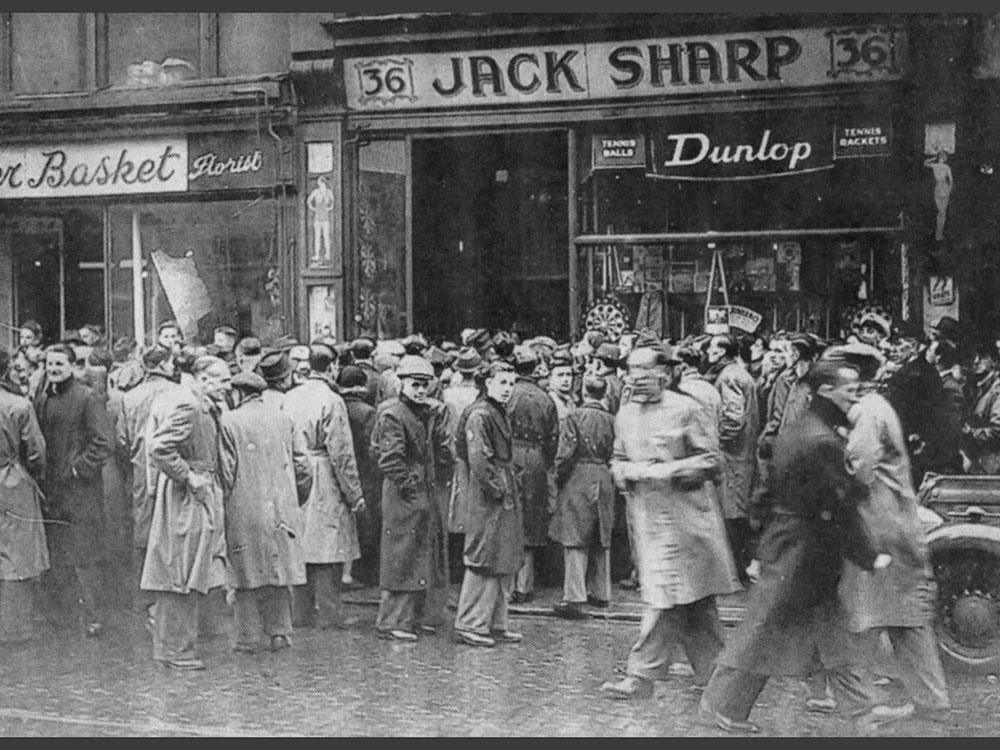
Queues for match tickets at the Whitechapel store
On the pitch Jack clocked up a remarkable 342 appearances in all competitions, contributing 76 goals. He was awarded two caps, but at a domestic level he had to content himself with just one winner’s medal, for the 1906 FA Cup. Frustratingly, Everton finished runners-up in the League on no fewer than three occasions (and finished third, twice) during his time there. He took over from fellow stalwart Jack Taylor as club captain but retired in 1911 to focus on his retail business and cricket. In the latter sphere, he appeared in three tests for England as well as representing his adopted county of Lancashire (often with Everton clubmate Harry Makepeace). He finally stepped away from playing cricket in 1925 and was given a life membership of Lancashire CCC in recognition of a county career reaping 22,015 runs and 434 wickets in 418 appearances.
During the First World War, Bert contributed to the war effort by working in a nearby munitions factory. The 1930s found him living and working in Withington, Manchester with his other brother, Fred, before retiring to the Sefton coast in the early 1940s. He passed away, unexpectedly, at home on Station Road, Ainsdale on 2 November 1949. His widow, Peg died less than four weeks later.
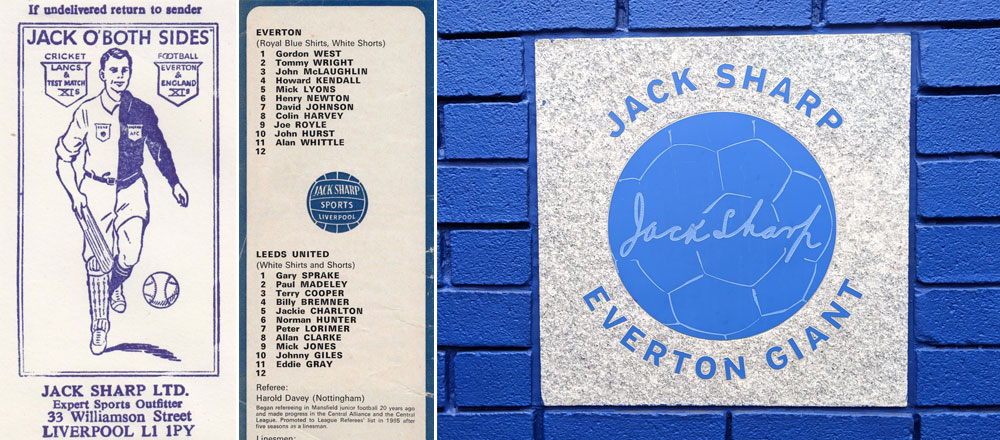
Left: Jack Sharp Sports logo; Middle: Programme team list with Jack Sharp Sports logo; Right: Jack Sharp — Everton Giant plaque
Jack’s business interests went from strength to strength and the Toffees sought to tap into his enterprise acumen and sporting knowledge by appointing him to the board of directors in 1922. He repaid their faith by being an active and enthusiastic club servant - running the rule over many potential signings. One of his lasting legacies was his insistence that the Blues press ahead with attempts to sign Wrexham’s promising centre-half, T.G. Jones in 1936.
Jack Sharp passed away on 28 January 1938 at home at 243 Queens Drive, having contracted bronchitis while on holiday in Harrogate. The ensuing cardiac asthma cost him his life at the age of 59. His namesake son would join the Everton board after the Second World War, serving on it until his death in 1979; this included a period as chairman which took in the 1969/70 League title win. Everton players would be given tokens to collect their football boots from the Whitechapel stall and the matchday programme would bear the Jack Sharp Sports logo as the match ball sponsor. In time, the business would be sold to JJB Sports and the iconic Whitechapel store and one in Runcorn eventually closed.
Members of the Sharp family continue to support the team with whom they have a connection going back 125 years.
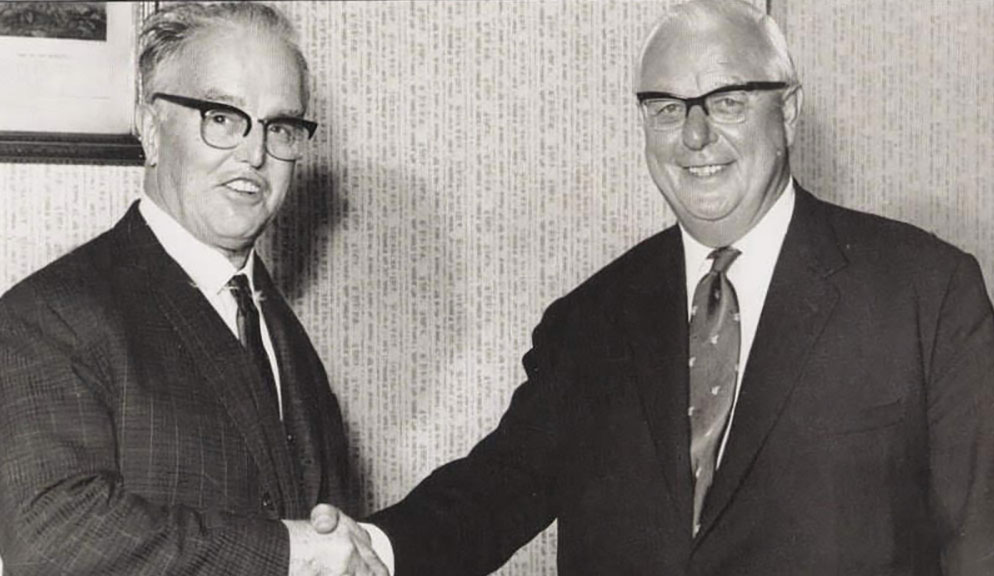
John Moores and Jack Sharp Junior in the late 1960s
Further reading: Jack O'Both Sides — The Life and Times of Jack Shar
Author’s note: I’d love to hear from any descendants of Bert Sharp, they can reach me through the ToffeeWeb contact form.
Acknowledgments and sources:
Thank you to the Sharp Family (Oliver Sharp and the late David Dunkley)
Roy Cavanagh M.B.E.
Brendan Connolly
Two Men for All Seasons (The story of Harry Makepeace and Jack Sharp) by Roy Cavanagh
Everton: The Official Complete Record (Steve Johnson)
The Everton Encyclopedia (James Corbett)
Goodison Glory (Ken Rogers)
englandfootballonline.com
The Everton board minutes (Everton Collection website)
Newspaper reports from the Blue Correspondent website (curated by Billy Smith)
saintsplayers.co.uk
Reader Comments (14)
Note: the following content is not moderated or vetted by the site owners at the time of submission. Comments are the responsibility of the poster. Disclaimer ()
2 Posted 19/11/2024 at 09:58:55
I'm not into cricket, but if I recall, one of the Neville brothers was a decent cricketer. And although he did hit the footballing heights, didn't Ian Botham play for Scunthorpe United, before choosing cricket?
3 Posted 19/11/2024 at 10:47:11
Dennis was also well known for earning good money advertising Brylcream hair moisturiser, I think Johnny Haynes, Fulham footballer, also did the same advertisement later on.
4 Posted 19/11/2024 at 10:50:31
Beefy played for Scunthorpe while he was an established England cricketer, it's incredible really.
5 Posted 19/11/2024 at 11:18:35
I wasn't an allrounder, just football and running. I could do a decent 400m!!
Dave, I often got to the Uxbridge cricket ground, where Middlesex sometimes play their matches. I confess to only going for the food as they do a good Sunday roast and the family like it.
I sit and watch the football on the big screens.
I'm not sure, but I think I heard the Aigburth cricket ground no longer exists?
6 Posted 19/11/2024 at 11:20:08
Truly a chosen one.
7 Posted 19/11/2024 at 12:13:22
8 Posted 19/11/2024 at 12:43:22
The shop in the day was legendary and stirs memories going past the place it stood to this day.
9 Posted 19/11/2024 at 15:48:40
In the '60s, Jack Sharp's seemed like the only place to go in the city centre for football and other sports kit. I remember also it was the only place in the city centre where you could buy match tickets in advance.
The photo with the comedian and music hall star George Robey is a classic.
10 Posted 19/11/2024 at 17:09:32
11 Posted 19/11/2024 at 21:28:15
But as a shop assistant once said to me, “I fear Sir has champagne tastes, but a beer income”!
12 Posted 21/11/2024 at 08:29:13
I am left with a real admiration for true giants who helped shape the history of our great club and whose values and ethos are often so sadly lacking in today's world.
13 Posted 21/11/2024 at 12:00:58
15 Posted 27/12/2025 at 03:33:40
I just came across this article… wow!! I am Bert Sharp's granddaughter. I would love any more information you may have on my grandfather and great uncle.
I believe you may be able to get my email from ToffeeWeb to email me directly. I look forward to hearing from you.
Thanks
Add Your Comments
In order to post a comment, you need to be logged in as a registered user of the site.
Or Sign up as a ToffeeWeb Member — it's free, takes just a few minutes and will allow you to post your comments on articles and Talking Points submissions across the site.
How to get rid of these ads and support TW


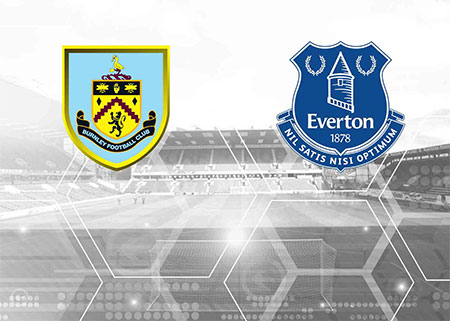







1 Posted 19/11/2024 at 09:39:40
Thanks for this story, Rob. What an Aladdin's Cave that shop was, all the kits downstairs then Scalextric and Subbuteo on the 1st floor.